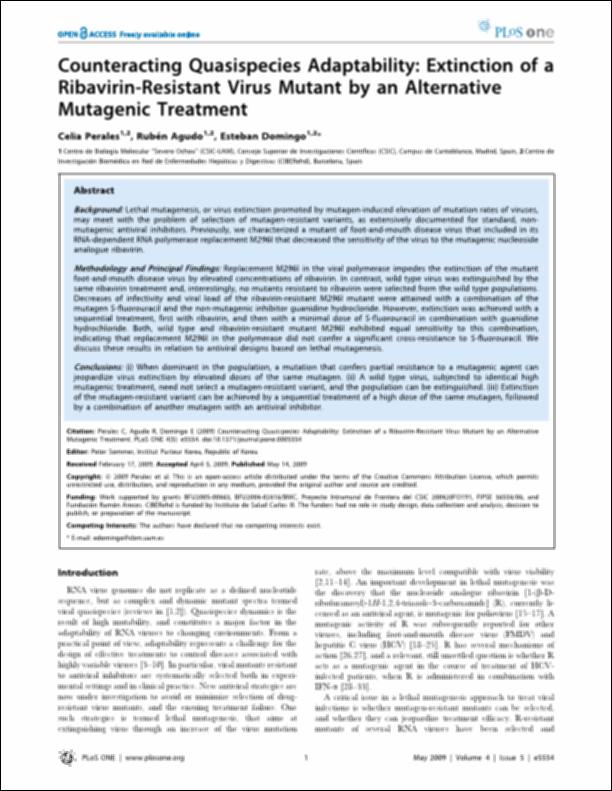Por favor, use este identificador para citar o enlazar este ítem:
http://hdl.handle.net/10637/15648Counteracting Quasispecies Adaptability: Extinction of a Ribavirin-Resistant Virus Mutant by an Alternative Mutagenic Treatment
| Título : | Counteracting Quasispecies Adaptability: Extinction of a Ribavirin-Resistant Virus Mutant by an Alternative Mutagenic Treatment |
| Autor : | Perales, Celia Agudo Torres, Rubén Domingo, Esteban |
| Materias: | Ribavirin; Virus; Mutagenic agent |
| Editorial : | Public Library of Science |
| Citación : | Perales C, Agudo R, Domingo E (2009) Counteracting Quasispecies Adaptability: Extinction of a Ribavirin-Resistant Virus Mutant by an Alternative Mutagenic Treatment. PLoS ONE 4(5): e5554. doi:10.1371/journal.pone.0005554 |
| Resumen : | Background: Lethal mutagenesis, or virus extinction promoted by mutagen-induced elevation of mutation rates of viruses, may meet with the problem of selection of mutagen-resistant variants, as extensively documented for standard, nonmutagenic antiviral inhibitors. Previously, we characterized a mutant of foot-and-mouth disease virus that included in its RNA-dependent RNA polymerase replacement M296I that decreased the sensitivity of the virus to the mutagenic nucleoside analogue ribavirin. Methodology and Principal Findings: Replacement M296I in the viral polymerase impedes the extinction of the mutant foot-and-mouth disease virus by elevated concentrations of ribavirin. In contrast, wild type virus was extinguished by the same ribavirin treatment and, interestingly, no mutants resistant to ribavirin were selected from the wild type populations. Decreases of infectivity and viral load of the ribavirin-resistant M296I mutant were attained with a combination of the mutagen 5-fluorouracil and the non-mutagenic inhibitor guanidine hydrocloride. However, extinction was achieved with a sequential treatment, first with ribavirin, and then with a minimal dose of 5-fluorouracil in combination with guanidine hydrochloride. Both, wild type and ribavirin-resistant mutant M296I exhibited equal sensitivity to this combination, indicating that replacement M296I in the polymerase did not confer a significant cross-resistance to 5-fluorouracil. We discuss these results in relation to antiviral designs based on lethal mutagenesis. Conclusions: (i) When dominant in the population, a mutation that confers partial resistance to a mutagenic agent can jeopardize virus extinction by elevated doses of the same mutagen. (ii) A wild type virus, subjected to identical high mutagenic treatment, need not select a mutagen-resistant variant, and the population can be extinguished. (iii) Extinction of the mutagen-resistant variant can be achieved by a sequential treatment of a high dose of the same mutagen, followed by a combination of another mutagen with an antiviral inhibitor. |
| URI : | http://hdl.handle.net/10637/15648 |
| Derechos: | http://creativecommons.org/licenses/by-nc-nd/4.0/deed.es OpenAccess |
| ISSN : | 1932-6203 |
| Fecha de publicación : | 14-may-2009 |
| Aparece en las colecciones: | Facultad de Farmacia |
Los ítems de DSpace están protegidos por copyright, con todos los derechos reservados, a menos que se indique lo contrario.


